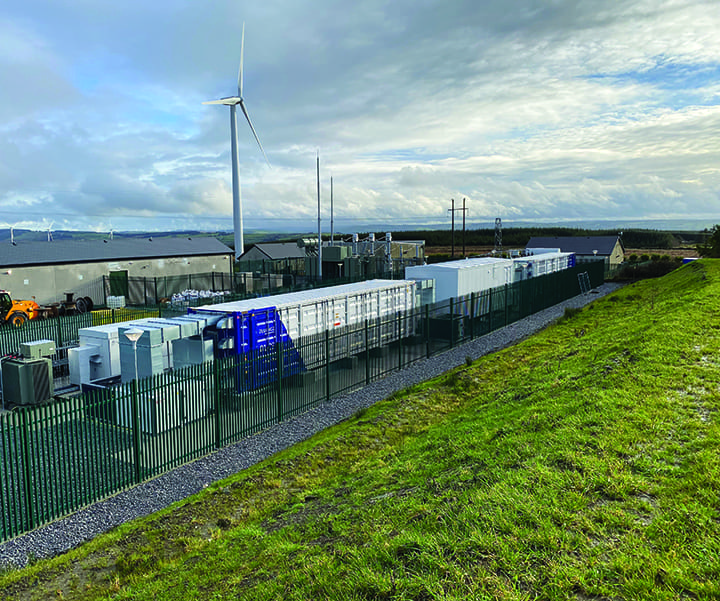Analysts: Storage a Matter of Dollars and Sense
More developers are adding energy storage to their power generation plans as they recognize how the technology improves a project’s economics.
Solar and wind power project developers are recognizing the financial benefits that incorporating energy storage into their projects provides. Storage has become a major part of microgrid configurations, and commercial and industrial (C&I) enterprises are discovering it can improve the cost-effectiveness of their own installations. Continuing technology advancements bode well for growth in the sector as investments in storage become more attractive.
Analysts have said that global outlays of $374 billion a year will be needed to upgrade the power grid with enough flexibility to account for the intermittent power generation profiles of renewables such as solar and wind. The Rocky Mountain Institute in a recent report detailed the multibillion-dollar potential of energy storage as part of those investments. The group said, “Total manufacturing investment, both previous and planned until 2023, represents around $150 billion, and analysts expect the capital cost for new planned battery manufacturing capacity to drop by more than half from 2018 to 2023.”
Though pumped-storage technology has been around for years, other storage technologies are newer, with the power generation industry still learning about the benefits—and challenges—that storage brings. Financial institutions and other potential investors in the space are working to become familiar with what storage means to the electricity sector, particularly because projects have unique characteristics based on generation sources, location, and their regional market.
 |
|
1. This Fluence energy storage system is located at Statkraft’s Kilathmoy Wind Farm in Ireland. Such systems enable storage of excess energy from renewable energy projects and provide flexibility in the dispatch of electricity. Courtesy: Fluence |
“Energy storage is a unique power asset in that it can both discharge and absorb energy, acting as a generation or storage asset as needed [Figure 1],” Ray Hohenstein, market applications director for Fluence, told POWER. “This flexibility allows it to play multiple roles on the electric grid, including regulating power flows, providing critical peak power and ultra-fast black start capabilities, and helping other assets [both generation, and transmission and distribution (T&D)] operate more efficiently—all of which reduces costs as well as emissions.”
“I would say historically, energy storage is still quite new,” said Jacqueline DeRosa, vice president of battery energy storage at Ameresco, in an interview with POWER. “Energy storage hasn’t really been able to be monetized.”
DeRosa pointed to a program—Massachusetts’ State of Charge Energy Storage Initiative (ESI)—that addresses that issue. The program “recognizes the potential benefits of incorporating advanced storage technologies into Massachusetts energy portfolio. The ESI aims to achieve the benefits by pursuing a multi-pronged approach to establishing an energy storage market structure, building strategic partnerships and supporting storage projects at the electric wholesale system, utility distribution system, and customer-side scale.”
DeRosa said the program “looked at all the different use cases of energy storage, and the value it provides to ratepayers. If you’re an energy storage [technology] that could be used to replace a gas-fired peaking plant, that [gas] plant might only get started a few times a year. The storage can provide many services, it can load-follow and provide peaking power. It can reduce carbon emissions. You can use the storage resource to do the same thing that power plant was doing. In every single use case, it was cost-effective. Other states have since done their own studies, and they’ve found that they need to put energy storage in place.”
Better Economics for Utilities
“Utilities are finding that energy storage is a more cost-effective solution for many grid needs than traditional power generation or T&D assets,” said Hohenstein. “In utility territories with high renewable penetration and where peaking needs are limited to a few hours a day, many utilities are finding energy storage more cost-effective than building new gas infrastructure. The business case for energy storage pencils out sooner than it would for other types of generation. Utilities are finding they can solve needs faster, address them with more surgical precision, and improve deployment of capital and modernization of the electric grid.”
Researchers from the Massachusetts Institute of Technology and Princeton in a recent report identified several applications where storage brings value, including providing operating reserves to power system operators, avoiding the cost of fuel, and eliminating the wear and tear incurred by cycling on and off gas-fired power plants. Putting storage at locations along the grid also can enhance transmission reliability and resiliency.
“Utilities can defer capex [capital expenditures] by incorporating distributed energy storage as a non-wires alternative to replace or upgrade transformers or distribution lines,” Dan Schnitzer, CEO and co-founder of SparkMeter, a grid management solutions company, told POWER. “They can also reduce exposure to peak wholesale energy costs through energy arbitrage by charging batteries during off-peak hours, and discharging at peak times.”
 |
|
2. This is a rendering of Fluence’s 6th-generation technology, in this case its Edgestack system for commercial and industrial customers. Courtesy: Fluence |
Schnitzer noted the importance of that value to C&I enterprises (Figure 2). “Some of the highest energy cost exposure to a C&I user is coincident peak demand charges. These coincident charges are incurred at extremely high rates when the peak demand of a large user of power occurs at the same time as a system peak demand,” said Schnitzer. “Having on-site storage can reduce exposure to such charges.”
Hohenstein provided an example. “Many C&I clients have utility tariffs with both an energy (per kWh) and demand (per kW) charge component. Sometimes the demand charge can be 40–60% of the total monthly electricity bill. Battery energy storage systems can flatten the load profile of the client by charging during off-peak times and discharging during the client’s peak. As a result, C&I customers can reduce their demand charge by 25–50%, which would reduce the total electricity bill by 10–30%.”
Large-Scale Adoption
Widespread, large-scale adoption of battery energy storage will likely be driven by utilities, such as the installations in California supported by Southern California Edison and Pacific Gas & Electric that at present are the world’s largest.
“Before utilities are able to deploy DERs [distributed energy resources], including distributed storage assets, at scale, they need to have a better understanding of the performance of their existing distribution network on a more granular basis,” said Schnitzer. “Right now, utilities have little visibility into the ‘secondary’ or low-voltage side of their network—the part of the network that serves most of their customers.”
DeRosa said utilities need to identify the ancillary services storage provides. “Many times it doesn’t pencil, because the value of the many services may not align with the single service” a customer is looking at, she said. For example, a utility could upgrade or build a new power plant to provide additional generation. “But now you could put energy storage there, and if it could participate in the wholesale market, it could help the grid,” DeRosa said. “That’s an example where the market design doesn’t fit [storage] yet. You want to defer your distribution upgrades, so put in storage, and along with the [capital] deferral, you use the storage for other services. Those rules don’t necessarily exist [today],” she said.
Utilities are listing storage as part of their future resource plans. Wood Mackenzie research earlier this year showed combined resource plans anticipate 6.3 GW of battery deployments this decade.
“With non-wires alternatives, it requires a market design that has to evolve, to allow for the non-wires alternatives to do multiple things… to make the different uses of energy storage work within the market design,” DeRosa said. “The world wasn’t designed for this initially.”
Schnitzer said the evolution includes tools to help utilities better analyze the value of storage and other DERs. “At SparkMeter, we are building a platform for smart meter data analytics that shows the real-time and historical performance of system assets like transformers and lines at the secondary level so that utilities can have a precise understanding of the size, location, and cost for DERs like storage to be most useful,” he said.
Technology and Investment
Improvements in storage technologies, particularly batteries, should bring more investment to the space. Rick Luebbe, CEO of Group14 Technologies—a company recently selected by the U.S. Department of Energy to receive $3.96 million in a project to develop advanced battery technology—told POWER advancements likely will include a move beyond today’s lithium-ion batteries that dominate the space.
“The battery landscape is crowded, and the winners will be the ones that can deliver the highest energy density at the lowest possible cost,” Luebbe said. “In order to revolutionize the energy storage market, we need to displace incumbent lithium-ion technology with novel approaches such as silicon-carbon, which creates outstanding first-cycle efficiency and longer lifecycle, so we can overcome the energy density limitations of traditional lithium-ion batteries.”
Group14 has developed SCC55. Luebbe said the product is “a silicon-carbon composite anode material with 5x the energy density of graphite, with cost, scalability, and performance, all top of mind. New technologies must deliver better performance without adding cost to any aspect of the product. This means the improved technology must be fundamentally less expensive, and not push cost to other aspects of the storage system.”
Luebbe said his company’s “improved anode technology is a drop-in for current anode materials. No changes are required for any other element of the product design or the manufacturing process. On top of that, the flexible nature of our manufacturing technology gives us the ability to provide application-specific performance across a spectrum of diverse markets including electric vehicles, consumer electronics, medical devices and aerospace. This value simplicity is the key to rapid product adoption.” ■
—Darrell Proctor is associate editor for POWER (@POWERmagazine).